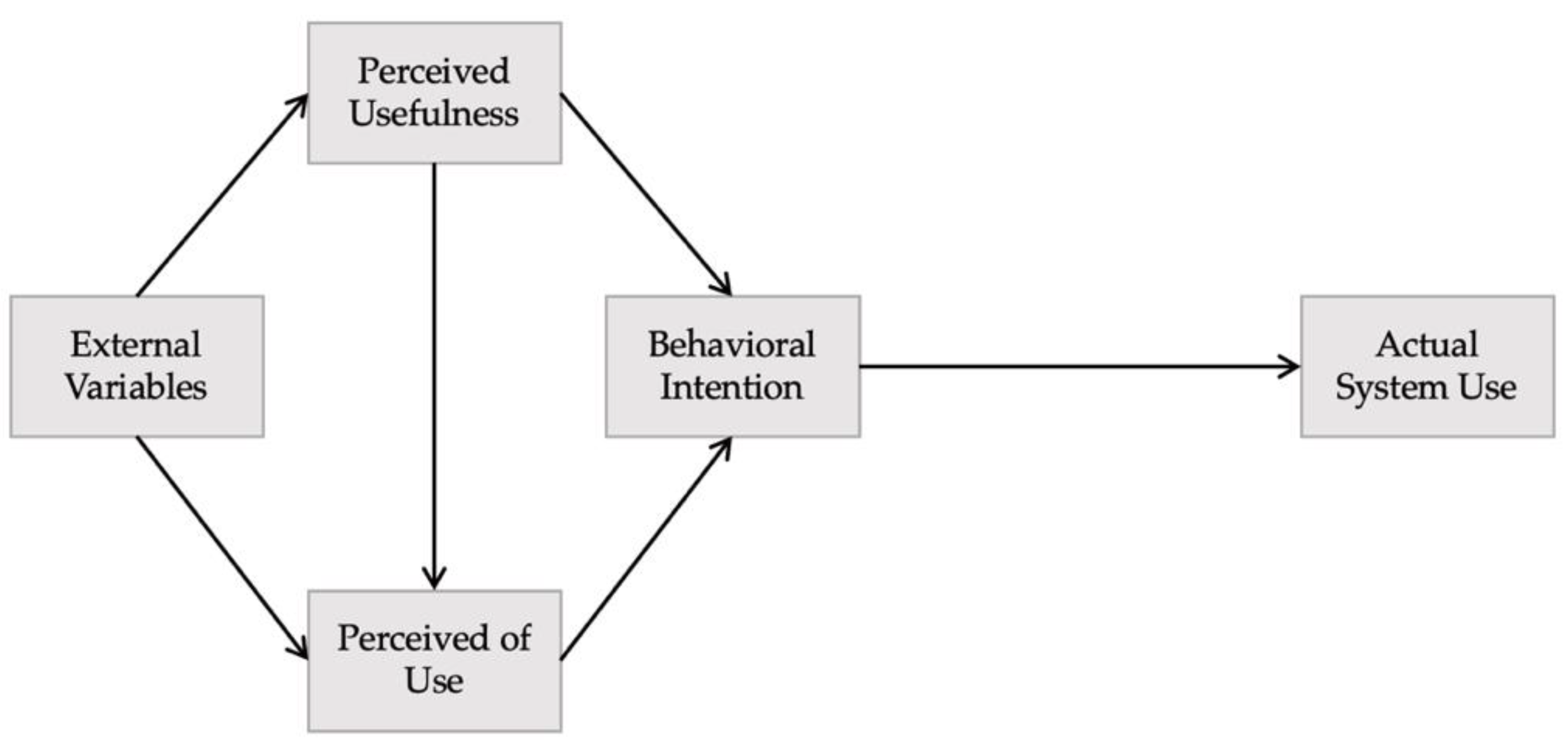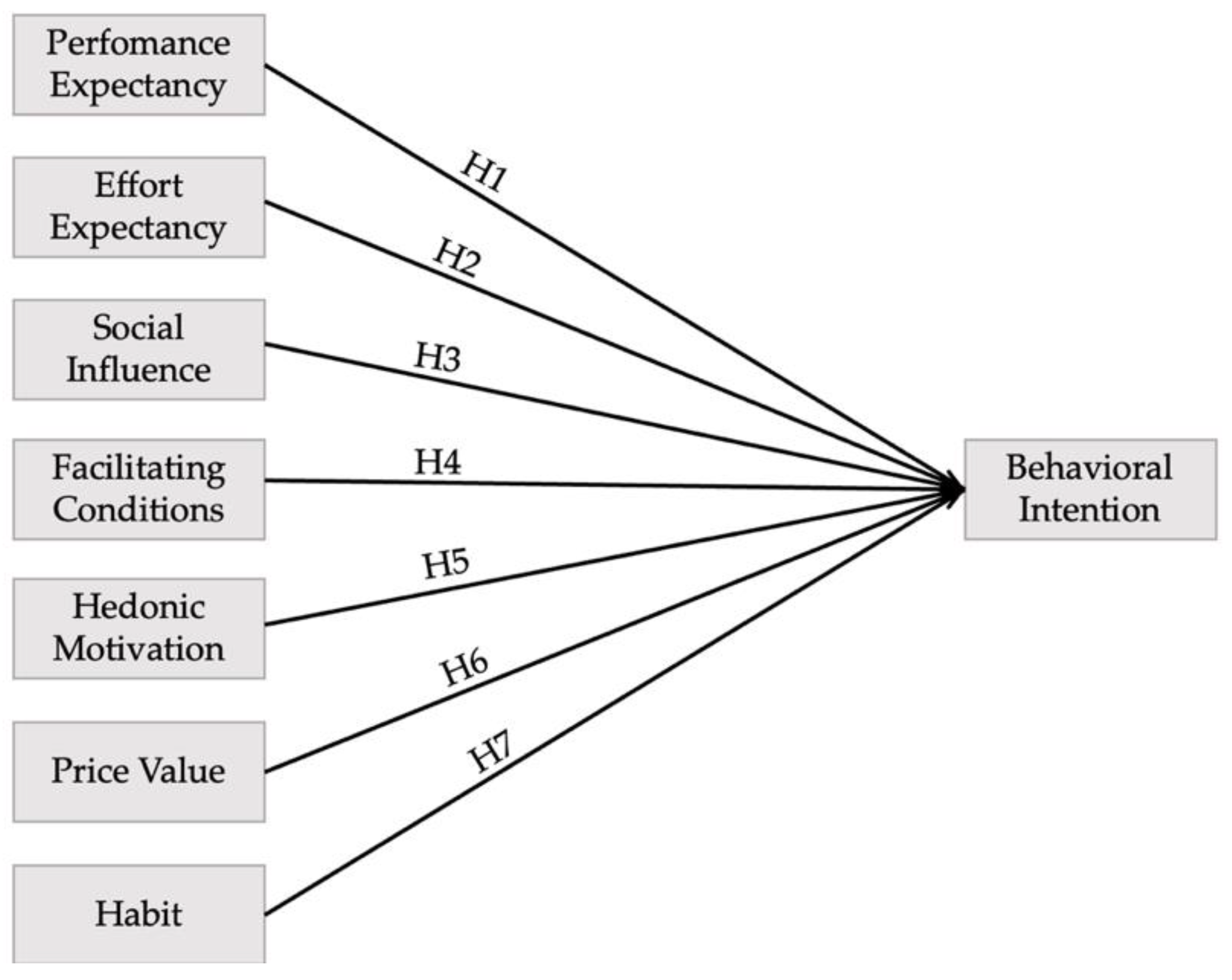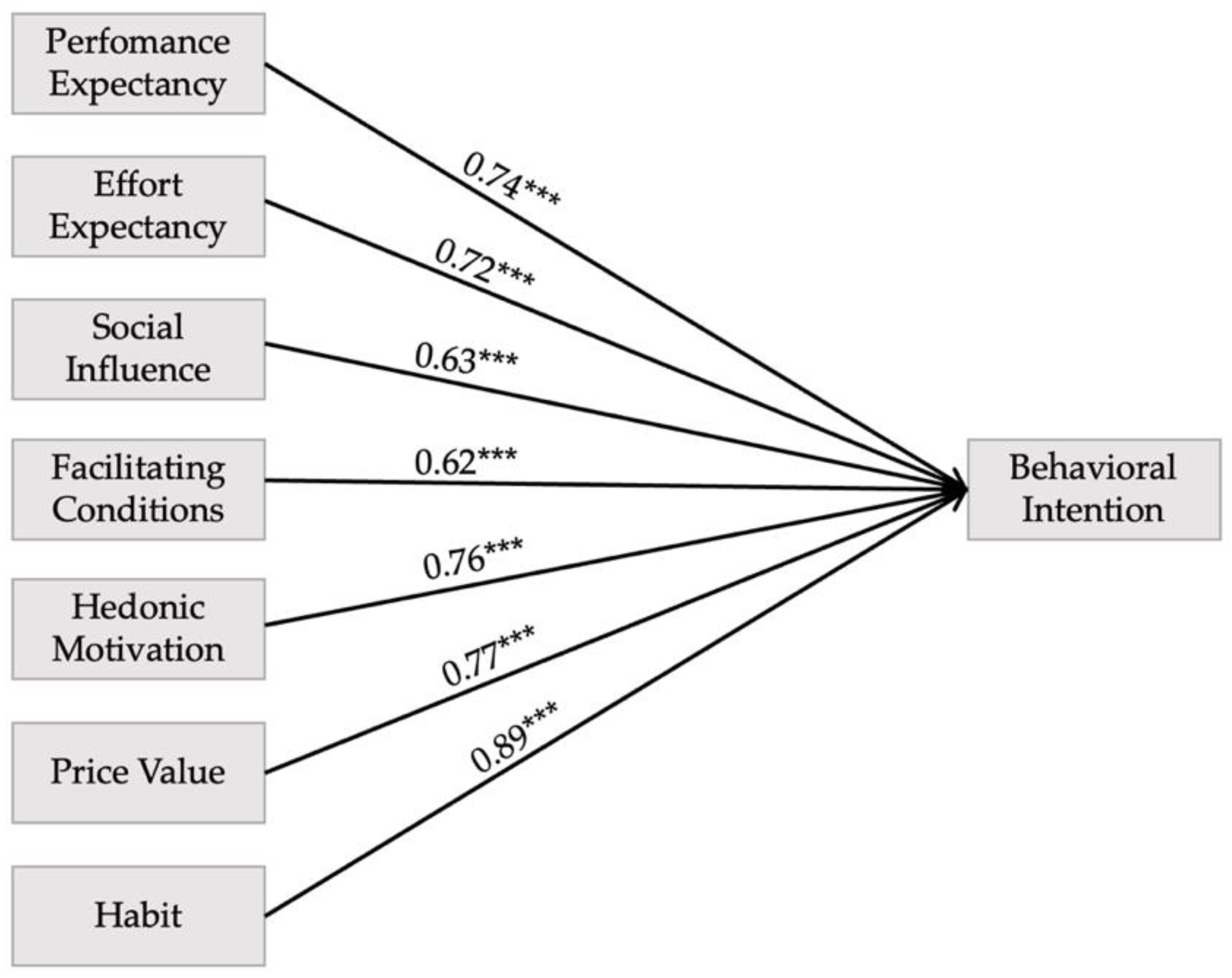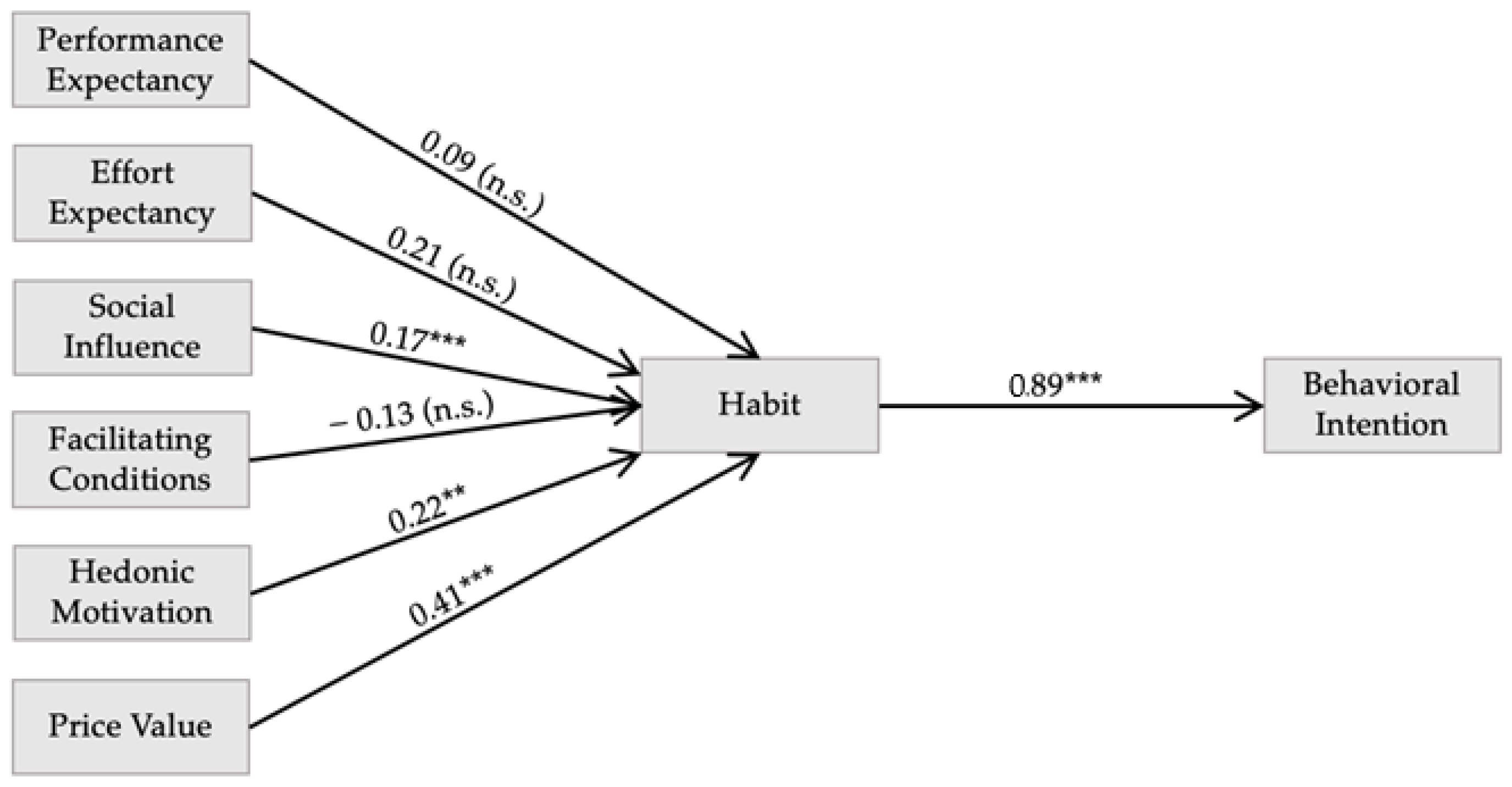Digitalization as a Provider of Sustainability?—The Role and Acceptance of Digital Technologies in Fashion Stores
Abstract
1. Introduction
2. Literature Review
2.1. Digitalization Imperative for Management and Marketing
2.2. Digital Technologies as Change Agents
2.3. Sustainability
2.4. Technology-Acceptance
2.4.1. Technology-Acceptance-Model
2.4.2. Unified Theory of Acceptance and Use of Technology 2
3. Methodology
3.1. Research Design
3.2. Measuring Instruments
3.3. Data Analysis
4. Results
5. Digitalization 4 Sustainability Framework
6. Discussion
7. Conclusions
8. Implications and Limitations
Supplementary Materials
Funding
Institutional Review Board Statement
Informed Consent Statement
Data Availability Statement
Conflicts of Interest
Appendix A
| Variables | b | SE | β | T | p |
|---|---|---|---|---|---|
| Perf. Expect. | 0.109 | 0.074 | 0.093 | 1.471 | n.s. |
| Effort Expect. | 0.142 | 0.093 | 0.119 | 1.518 | n.s. |
| Social Infl. | 0.079 | 0.045 | 0.075 | 1.754 | n.s. |
| Facil. Cond. | −0.030 | 0.078 | −0.025 | −0.384 | n.s. |
| Hed. Motiv. | 0.260 | 0.076 | 0.023 | 0.340 | n.s. |
| Price Value | −0.009 | 0.079 | −0.008 | −0.118 | n.s. |
| Habits | 0.746 | 0.072 | 0.683 | 10.396 | *** |
| R2 (adj.) | 0.796 |
| Variables | b | SE | β | T | p |
|---|---|---|---|---|---|
| Perf. Expect. | 0.182 | 0.092 | 0.156 | 1.988 | * |
| Effort Expect. | 0.312 | 0.114 | 0.263 | 2.733 | ** |
| Social Infl. | 0.199 | 0.054 | 0.189 | 3.658 | *** |
| Facil. Cond. | −0.132 | 0.097 | −0.111 | −1.362 | n.s. |
| Hed. Motiv. | 0.191 | 0.092 | 0.170 | 2.073 | * |
| Price Value | 0.310 | 0.091 | 0.271 | 3.416 | *** |
| R2 (adj.) | 0.683 |
References
- Chwallek, A.; Wilhelm, S. Kein Konzept ist ausgeschlossen. Der Handel 2016, 10, 10–16. [Google Scholar]
- Bovensiepen, G.; Rumpff, S.; Bender, S. Store 4.0—Zukunft des stationären Handels; PricewaterhouseCoopers: London, UK, 2016; Available online: https://www.pwc.ch/de/publications/2017/store-4.0-zukunft-des-stationaeren-handels-pwc-1.pdf (accessed on 22 November 2022).
- Böcker, J. Die Customer Journey—Chance für mehr Kundennähe. In Dialogmarketing Perspektiven 2014/2015: Tagungsband 9. Wissenschaftlicher Interdisziplinärer Kongress für Dialogmarketing; Deutscher Dialogmarketing Verband, e.V., Ed.; Springer: Wiesbaden, Germany, 2015; pp. 165–177. ISBN 9783658088767. [Google Scholar]
- Porter, M.E.; Kramer, M.R. The Competitive Advantage of Corporate Philanthropy. Harv. Bus. Rev. 2002, 80, 56–68. [Google Scholar]
- Porter, M.E.; Kramer, M.R. Creating Shared Value. Harv. Bus. Rev. 2011, 89, 62–77. [Google Scholar]
- Deloitte. Disruptions in Retail through Digital Transformation—Reimagining the Store of the Future; Deloitte Global: New York, NY, USA, 2017; Available online: https://www2.deloitte.com/content/dam/Deloitte/in/Documents/CIP/in-cip-disruptions-in-retail-noexp.pdf (accessed on 22 November 2022).
- Amed, I.; Balchandani, A.; Beltrami, M.; Berg, A.; Hedrich, S.; Rölkens, F. The State of Fashion 2019; McKinsey&Company: Hongkong, China, 2019; Available online: https://www.mckinsey.com/~/media/mckinsey/industries/retail/our%20insights/the%20state%20of%20fashion%202019%20a%20year%20of%20awakening/the-state-of-fashion-2019-final.ashx (accessed on 22 November 2022).
- Deloitte. Digital Disruptions in Retail; Deloitte Global: New York, NY, USA, 2020; Available online: https://www2.deloitte.com/content/dam/Deloitte/in/Documents/consumer-business/in-consumer-Digital%20Disruption%20in%20Retail_Retail%20Leadership%20Summit%202020%20Report.pdf (accessed on 4 February 2023).
- Amed, I.; Berg, A.; Balchandani, A.; Hedrich, S.; Rölkens, F.; Young, R.; Jensen, J.E.; Peng, E. The State of Fashion 2021; McKinsey&Company: Hongkong, China, 2021; Available online: https://www.mckinsey.com/~/media/mckinsey/industries/retail/our%20insights/state%20of%20fashion/2021/the-state-of-fashion-2021-vf.pdf (accessed on 4 February 2023).
- Iannilli, V.M.; Spagnoli, A. Phygital Retailing in Fashion. Experiences, Opportunities and Innovation Trajectories. ZoneModa J. 2021, 11, 43–69. [Google Scholar] [CrossRef]
- Alexander, B.; Kent, A. Tracking technology diffusion in-store: A fashion retail perspective. Int. J. Retail. Distrib. Manag. 2021, 49, 1369–1390. [Google Scholar] [CrossRef]
- Fritz, K. Wer ist hier Sklave, wer Herr? Frankfurter Allgemeine Zeitung: Hessen, Germany, 2015; p. 11. [Google Scholar]
- Becker, W.; Botzkowski, T.; Eurich, S.; Ulrich, P. Data Analytics in Familienunternehmen—Implikationen für das Controlling. Z. Erfolgsorientierte Unternehm. 2015, 27, 263–268. [Google Scholar] [CrossRef]
- Wynn, M.; Jones, P. Digital Technology Deployment and the Circular Economy. Sustainability 2022, 14, 9077. [Google Scholar] [CrossRef]
- Krickel, F. Digitalisierung in der Energiewirtschaft. In Zukunftsorientierte Unternehmenssteuerung in der Energiewirtschaft; Hecker, W., Krickel, F., Lau, C., Müller, A., Eds.; Springer: Wiesbaden, Germany, 2015; pp. 42–43. ISBN 9783658078157. [Google Scholar]
- Schütte, R.; Vetter, T. Analyse des Digitalisierungspotentials von Handelsunternehmen. In Handel 4.0: Die Digitalisierung des Handels; Gläß, R., Leukert, B., Eds.; Springer: Berlin, Germany, 2017; p. 85. ISBN 9783662533314. [Google Scholar]
- Pazaitis, A. Breaking the Chains of Open Innovation: Post-Blockchain and the Case of Sensorica. Information 2020, 11, 104. [Google Scholar] [CrossRef]
- Grewal, D.; Gauri, D.K.; Das, G.; Agarwal, J.; Spence, M.T. Retailing and emergent technologies. J. Bus. Res. 2021, 134, 198–202. [Google Scholar] [CrossRef]
- Große-Holtforth, D. Schlüsselfaktoren im E-Commerce: Innovationen, Skaleneffekte, Daten und Kundenzentrierung; Springer: Wiesbaden, Germany, 2017; pp. 13–15. ISBN 9783658164331. [Google Scholar]
- Banken, R. Schneller Strukturwandel trotz institutioneller Stabilität. Die Entwicklung des deutschen Einzelhandels 1949–2000. Jahrb. Wirtsch. Econ. Hist. Yearb. 2007, 48, 117–146. [Google Scholar] [CrossRef]
- Frey, C.B.; Osborne, M.A. The Future of Employment: How Susceptible are Jobs to Computerization? Technol. Forecast. Soc. Chang. 2013, 114, 254–280. [Google Scholar] [CrossRef]
- Loebbecke, C. Digitalisierung: Technologien und Unternehmensstrategien. In Handbuch Medienmanagement; Scholz, C., Ed.; Springer: Heidelberg, Germany, 2006; pp. 357–373. ISBN 9783540235408. [Google Scholar]
- Yoo, Y.; Henfridsson, O.; Lyytinen, K. Research commentary—The new organizing logic of digital innovation: An agenda for information systems research. Inf. Syst. Res. 2010, 21, 724–735. [Google Scholar] [CrossRef]
- Fitzgerald, M.; Kruschwitz, N.; Bonnet, D.; Welch, M. Embracing digital technology: A new strategic imperative. MIT Sloan Manag. Rev. 2014, 55, 1. [Google Scholar]
- Rasche, C.; Margaria, T.; Floyd, B.D. Service Model Innovation in Hospitals: Beyond Expert Organizations. In Service Business Model Innovation in Healthcare and Hospital Management—Models, Strategies Tools; Pfannstiel, M., Rasche, C., Eds.; Springer: Wiesbaden, Germany, 2017; pp. 1–19. ISBN 9783319835150. [Google Scholar]
- Liébana-Cabanillas, F.; García-Maroto, I.; Muñoz-Leiva, F.; Ramos-de-Luna, I. Mobile Payment Adoption in the Age of Digital Transformation: The Case of Apple Pay. Sustainability 2020, 12, 5443. [Google Scholar] [CrossRef]
- Vashishtha, V.; Kashyap, R. Reconfigure the apparel retail stores with interactive technologies. Res. J. Text. Appar. 2022, 27, 54–73. [Google Scholar] [CrossRef]
- Kupper, A.; Bareth, U.; Freese, B. Geofencing and background tracking—The next features in LBSs. 41. In Proceedings of the Jahrestagung der Gesellschaft für Informatik, Berlin, Germany, 4–7 October 2010. [Google Scholar]
- Zhu, G.; Gao, X. Precision Retail Marketing Strategy Based on Digital Marketing Model. Sci. J. Bus. Manag. 2019, 1, 33–37. [Google Scholar] [CrossRef]
- Reinartz, W.; Wiegand, N.; Imschloss, M. The impact of digital transformation on the retailing value chain. Int. J. Res. Mark. 2019, 36, 350–366. [Google Scholar] [CrossRef]
- Rienda, L.; Ruiz-Fernández, L.; Carey, L. Analysing trademark and social media in fashion industry: Tools that impact performance and internationalization for SMEs. J. Fash. Mark. Manag. 2021, 25, 117–132. [Google Scholar] [CrossRef]
- Garaus, M.; Wagner, U.; Rainer, R.C. Emotional targeting using digital signage systems and facial recognition at the point-of-sale. J. Bus. Res. 2021, 131, 747–762. [Google Scholar] [CrossRef]
- Visser, J.; Nemoto, T.; Browne, M. Home Delivery and the Impacts on Urban Freight Transport: A Review. Procedia Soc. Behav. Sci. 2014, 125, 15–27. [Google Scholar] [CrossRef]
- Heinemann, G. Der neue Online-Handel—Geschäftsmodell und Kanalexzellenz im Digital Commerce; Springer: Wiesbaden, Germany, 2017; pp. 19–30. ISBN 9783658153830. [Google Scholar]
- Schäfer, S. Argumented und Virtual Reality im Handel: Einsatz. Available online: https://zukunftdeseinkaufens.de/augmented-und-virtual-reality-im-handel-einsatz-13/ (accessed on 22 November 2022).
- OECD. OECD Digital Economy Outlook 2020; OECD Publishing: Paris, France, 2020. [Google Scholar] [CrossRef]
- Hütz, S. Mode Anprobieren Wird Zum Erlebnis. Available online: https://www.stores-shops.de/technology/mode-anprobieren-wird-zum-erlebnis/ (accessed on 22 November 2022).
- Reinhold, K. Die digitale Aufholjagd. Textilwirtschaft 2016, 1B, 14–17. [Google Scholar]
- Yu, H.; Lee, H.; Jeon, H. What is 5G? Emerging 5G Mobile Services and Network Requirements. Sustainability 2017, 9, 1848. [Google Scholar] [CrossRef]
- Celko, M.; Janszky, S. Die Zukunft des Stationären Handels; Trendstudie des 2b AHEAD ThinkTanks: Washington, DC, USA, 2014; Available online: https://www.markant-magazin.com/sites/default/files/downloads/Studie%20-%20Die%20Zukunft%20des%20station%C3%A4ren%20Handels.pdf (accessed on 12 December 2022).
- Kornatowski, P.M.; Bhaskaran, A.; Heitz, G.M.; Mintchev, S.; Floreano, D. Last-Centimeter Personal Drone Delivery: Field Deployment and User Interaction. IEEE Robot. Autom. Lett. 2018, 3, 3813–3820. [Google Scholar] [CrossRef]
- Cleveland, J.; Thakur, D.; Dames, P.; Phillips, C.; Kientz, T.; Daniilidis, K.; Bergstrom, J.; Kumar, V. Automated System for Semantic Object Labeling with Soft-Object Recognition and Dynamic Programming Segmentation. IEEE Trans. Autom. Sci. Eng. 2017, 14, 820–833. [Google Scholar] [CrossRef]
- Shankar, V.; Kalvanam, K.; Setia, P.; Golmohammadi, A.; Tirunillai, S.; Douglass, T.; Hennessey, J.; Bull, J.S.; Waddoups, R. How Technology is Changing Retail. J. Retail. 2021, 97, 13–27. [Google Scholar] [CrossRef]
- Cipresso, P.; Giglioli, I.A.C.; Raya, M.A.; Riva, G. The past, present, and future of virtual and augmented reality research: A network and cluster analysis of the literature. Front. Psychol. 2018, 9, 2086. [Google Scholar] [CrossRef]
- McCarthy, J.; Minsky, M.L.; Rochester, N.; Shannon, C.E. A proposal for the dartmouth summer research project on artificial intelligence, August 31, 1955. AI Mag. 2006, 27, 12. [Google Scholar]
- Bengio, Y.; Courville, A.; Vincent, P. Representation learning: A review and new perspectives. IEEE Trans. Pattern Anal. Mach. Intell. 2013, 35, 1798–1828. [Google Scholar] [CrossRef]
- Bansal, P.; Song, H.-C. Similar but not the same: Differentiating corporate sustainability from corporate responsibility. Acad. Manag. Ann. 2017, 11, 105–149. [Google Scholar] [CrossRef]
- Ponte, S. Green capital accumulation: Business and sustainability management in a world of Global Value Chains. New Political Econ. 2020, 25, 72–84. [Google Scholar] [CrossRef]
- Balderjahn, I. Nachhaltiges Management und Kosumentenverhalten; UVK Verlag: Munich, Germany, 2021; pp. 11–16. ISBN 9783825254919. [Google Scholar]
- Griggs, D.; Stafford-Smith, M.; Gaffney, O.; Rockström, J.; Ohman, M.C.; Shyamsundar, P.; Noble, I. Policy: Sustainable development goals for people and planet. Nature 2013, 495, 305–307. [Google Scholar] [CrossRef] [PubMed]
- Vereinte Nationen. Ziele für Nachhaltige Entwicklung. Available online: https://unric.org/de/17ziele/ (accessed on 22 December 2022).
- Lee, B.X.; Kjaerulf, F.; Turner, S.; Cohen, L.; Donnelly, P.D.; Muggah, R.; Waller, I. Transforming our world: Implementing the 2030 agenda through sustainable development goal indicators. J. Public Health Policy 2016, 37, 13–31. [Google Scholar] [CrossRef] [PubMed]
- Thorisdottir, T.S.; Johannsdottir, L. Sustainability within fashion business models: A systematic literature review. Sustainability 2019, 11, 2233. [Google Scholar] [CrossRef]
- Chan, H.; Wei, X.; Guo, S.; Leung, W. Corporate social responsibility (CSR) in fashion supply chains: A multi-methodological study. Transp. Res. Part E Logist. Transp. Rev. 2020, 142, 102063. [Google Scholar] [CrossRef]
- Cambridge Dictionary. Acceptance. In Cambridge Dictionary; Cambridge University Press: Cambridge, UK, 2022; Available online: https://dictionary.cambridge.org/dictionary/english/acceptance (accessed on 22 December 2022).
- Oxford Dictionary. Acceptance. In OED Online; Oxford University Press: Oxford, UK, 2022; Available online: https://www.oed.com/view/Entry/1011 (accessed on 22 December 2022).
- Davis, F.D. A Technology Acceptance Model for Empirically Testing New End User Information Systems: Theory and Results. Doctoral Dissertation, Sloan School of Management, Cambridge, MA, USA, 1985. [Google Scholar]
- Kroeber-Riel, W.; Gröppel-Klein, A. Konsumentenverhalten; Vahlen: Munich, Germany, 2013; pp. 257–404. ISBN 9783800660339. [Google Scholar]
- Venkatesh, V.; Davis, F. A Theoretical Extension of the Technology Acceptance Model: Four Longitudinal Field Studies. Manag. Sci. 2000, 46, 186–204. [Google Scholar] [CrossRef]
- Kheiravar, S.; Richter, N. Neue Technologien im stationären Einzelhandel: Mobile Apps oder stationäre Geräte? In Digitalisierung im Vertrieb; Binckebanck, L., Elste, R., Eds.; Springer: Wiesbaden, Germany, 2016; pp. 609–631. ISBN 9783658050535. [Google Scholar]
- Venkatesh, V.; Morris, M.G.; Davis, G.B.; Davis, F.D. User acceptance of information technology: Toward a unified view. MIS Quarterly 2003, 27, 425–478. [Google Scholar] [CrossRef]
- Venkatesh, V.; Thong, J.; Xu, X. Consumer Acceptance and Use of Information Technology: Extending the Unified Theory of Acceptance and Use of Technology. MIS Q. 2012, 36, 157–178. [Google Scholar] [CrossRef]
- Williams, C. Research methods. J. Bus. Econ. Res. 2011, 5, 65–72. [Google Scholar] [CrossRef]
- Meffert, H. Marketing: Einführung in die Absatzpolitik; Springer: Wiesbaden, Germany, 1977; pp. 176–183. ISBN 9783409369718. [Google Scholar]
- Rasch, D.; Verdooren, L.; Gowers, J. Planung und Auswertung von Versuchen und Erhebungen; Oldenbourg: Munich, Germany, 2007; pp. 72–80. ISBN 9783486583007. [Google Scholar]
- Mishra, S.B.; Alok, S. Handbook of Research Methodology; Educreations: Palo Alto, CA, USA, 2017; pp. 8–10. ISBN 9781545703403. [Google Scholar]
- Bortz, J.; Döring, N. Forschungsmethoden und Evaluation in den Sozial- und Humanwissenschaften; Springer: Berlin, Germany, 2016; pp. 398–490. ISBN 9783642410888. [Google Scholar]
- Rosseel, Y. lavaan: An R Package for Structural Equation Modeling. J. Stat. Softw. 2012, 48, 1–36. [Google Scholar] [CrossRef]
- Field, A. Discovering Statistics Using IBM SPSS Statistics, 5th ed.; SAGE Publications: Thousand Oaks, CA, USA, 2018; pp. 1–976. [Google Scholar]
- Brown, T.A. Confirmatory Factor Analysis for Applied Research; Guilford Press: New York, NY, USA, 2015; pp. 1–462. ISBN 9781462517794. [Google Scholar]
- Bentler, P.M. Comparative fit indexes in structural models. Psychol. Bull. 1990, 107, 238–246. [Google Scholar] [CrossRef]
- Berger, C. Vom Gewohnheitstier zur reflektierten Nutzung—Ein Diskussionsanstoß über Betriebssysteme und Programmnutzung nachzudenken. Medienimpulse 2010, 48, 1–6. [Google Scholar]
- Funke, G.; Schmandt, J. Gewohnheit. Arch. Begr. 1961, 3, 7–606. [Google Scholar]
- Teo, A.C.; Tan, G.W.H.; Ooi, K.B.; Hew, T.S.; Yew, K.T. The effects of convenience and speed in m-payment. Ind. Manag. Data Syst. 2015, 115, 311–331. [Google Scholar] [CrossRef]
- EL Idrissi, T.; Idri, A.; Bakkoury, Z. Systematic map and review of predictive techniques in diabetes self-management. Int. J. Inf. Manag. 2019, 46, 263–277. [Google Scholar] [CrossRef]
- Chu, W.S.W. Factors Influencing Mobile Payment Adoption in Hong Kong: A Quantitative Study. Asian J. Bus. Manag. 2022, 10, 41–61. [Google Scholar] [CrossRef]
- Sulkowski, L.; Kaczorowska-Spychalska, D. Determinants of the adoption of AI wearables—Practical implications for marketing. Hum. Technol. 2021, 17, 294–320. [Google Scholar] [CrossRef]
- Mosquera, A.; Juaneda-Ayensa, E.; Olarte-Pascual, C.; Pelegrín-Borondo, J. Key Factors for In-Store Smartphone Use in an Om-nichannel Experience: Millennials vs. Nonmillennials. Complexity 2018, 2018, 1057356. [Google Scholar] [CrossRef]
- Charnley, F.; Knecht, F.; Muenkel, H.; Pletosu, D.; Rickard, V.; Sambonet, C.; Schneider, M.; Zhang, C. Can Digital Technologies Increase Consumer Acceptance of Circular Business Models? The Case of Second Hand Fashion. Sustainability 2022, 14, 4589. [Google Scholar] [CrossRef]







| Variable | 1 | 2 | 3 | 4 | 5 | 6 | 7 | 8 |
|---|---|---|---|---|---|---|---|---|
| 1. BI | 1 | 0.738 *** | 0.678 *** | 0.583 *** | 0.592 *** | 0.701 *** | 0.722 *** | 0.855 *** |
| 2. Perf. Expect. | 1 | 0.669 *** | 0.521 *** | 0.550 *** | 0.733 ** | 0.739 *** | 0.737 *** | |
| 3. Effort Expect. | 1 | 0.496 *** | 0.827 *** | 0.686 *** | 0.722 *** | 0.663 *** | ||
| 4. Social Influence | 1 | 0.408 *** | 0.554 *** | 0.597 *** | 0.627 *** | |||
| 5. Facil. Conditions | 1 | 0.649 *** | 0.678 *** | 0.571 *** | ||||
| 6. Hedonic Motiv. | 1 | 0.763 *** | 0.728 *** | |||||
| 7. Price Value | 1 | 0.790 *** | ||||||
| 8. Habit | 1 | |||||||
| Number of items | 3 | 4 | 4 | 3 | 3 | 3 | 3 | 4 |
| Mean | 4.03 | 4.74 | 4.69 | 3.80 | 4.70 | 4.46 | 4.48 | 4.10 |
| SD | 1.28 | 1.10 | 1.08 | 1.22 | 1.08 | 1.14 | 1.12 | 1.17 |
| Cronbach’s α | 0.94 | 0.94 | 0.94 | 0.95 | 0.89 | 0.96 | 0.89 | 0.88 |
| Network | Training | Testing | |||||
|---|---|---|---|---|---|---|---|
| N | SSE | RMSE | N | SSE | RMSE | Total Samples | |
| ANN 1 | 186 | 20.748 | 0.334 | 16 | 1.221 | 0.276 | 202 |
| ANN 2 | 180 | 15.515 | 0.294 | 22 | 3.746 | 0.413 | 202 |
| ANN 3 | 178 | 18.306 | 0.321 | 24 | 1.015 | 0.206 | 202 |
| ANN 4 | 181 | 20.871 | 0.340 | 21 | 2.048 | 0.312 | 202 |
| ANN 5 | 182 | 20.834 | 0.338 | 20 | 0.79 | 0.199 | 202 |
| ANN 6 | 180 | 15.439 | 0.293 | 22 | 2.053 | 0.305 | 202 |
| ANN 7 | 184 | 22.722 | 0.351 | 18 | 0.882 | 0.221 | 202 |
| ANN 8 | 177 | 13.524 | 0.276 | 25 | 3.142 | 0.355 | 202 |
| ANN 9 | 181 | 17.858 | 0.314 | 21 | 2.093 | 0.316 | 202 |
| ANN10 | 179 | 16.324 | 0.302 | 23 | 2.211 | 0.310 | 202 |
| Mean | 18.214 | 0.316 | 1.920 | 0.291 | |||
| SD | 3.0066 | 0.0246 | 0.9799 | 0.0678 | |||
| NN | PE | EE | SI | FC | HM | PV | H |
|---|---|---|---|---|---|---|---|
| NN 1 | 0.435 | 0.204 | 0.009 | 0.091 | 0.188 | 0.277 | 1.0 |
| NN 2 | 0.297 | 0.098 | 0.069 | 0.074 | 0.293 | 0.155 | 1.0 |
| NN 3 | 0.443 | 0.069 | 0.123 | 0.118 | 0.219 | 0.117 | 1.0 |
| NN 4 | 0.15 | 0.315 | 0.264 | 0.088 | 0.338 | 0.118 | 1.0 |
| NN 5 | 0.512 | 0.153 | 0.108 | 0.11 | 0.122 | 0.078 | 1.0 |
| NN 6 | 0.425 | 0.274 | 0.059 | 0.193 | 0.147 | 0.136 | 1.0 |
| NN 7 | 0.263 | 0.202 | 0.218 | 0.133 | 0.148 | 0.428 | 1.0 |
| NN 8 | 0.567 | 0.375 | 0.19 | 0.189 | 0.262 | 0.312 | 1.0 |
| NN 9 | 0.227 | 0.382 | 0.067 | 0.117 | 0.311 | 0.204 | 1.0 |
| NN10 | 0.33 | 0.224 | 0.083 | 0.207 | 0.186 | 0.186 | 1.0 |
| Averg. Importance | 0.36 | 0.23 | 0.21 | 0.13 | 0.22 | 0.2 | 1 |
| Normalized Importance (%) | 36.49 | 22.96 | 11.9 | 13.2 | 22.14 | 20.11 | 100.0 |
Disclaimer/Publisher’s Note: The statements, opinions and data contained in all publications are solely those of the individual author(s) and contributor(s) and not of MDPI and/or the editor(s). MDPI and/or the editor(s) disclaim responsibility for any injury to people or property resulting from any ideas, methods, instructions or products referred to in the content. |
© 2023 by the author. Licensee MDPI, Basel, Switzerland. This article is an open access article distributed under the terms and conditions of the Creative Commons Attribution (CC BY) license (https://creativecommons.org/licenses/by/4.0/).
Share and Cite
von der Assen, L. Digitalization as a Provider of Sustainability?—The Role and Acceptance of Digital Technologies in Fashion Stores. Sustainability 2023, 15, 4621. https://doi.org/10.3390/su15054621
von der Assen L. Digitalization as a Provider of Sustainability?—The Role and Acceptance of Digital Technologies in Fashion Stores. Sustainability. 2023; 15(5):4621. https://doi.org/10.3390/su15054621
Chicago/Turabian Stylevon der Assen, Louisa. 2023. "Digitalization as a Provider of Sustainability?—The Role and Acceptance of Digital Technologies in Fashion Stores" Sustainability 15, no. 5: 4621. https://doi.org/10.3390/su15054621
APA Stylevon der Assen, L. (2023). Digitalization as a Provider of Sustainability?—The Role and Acceptance of Digital Technologies in Fashion Stores. Sustainability, 15(5), 4621. https://doi.org/10.3390/su15054621





